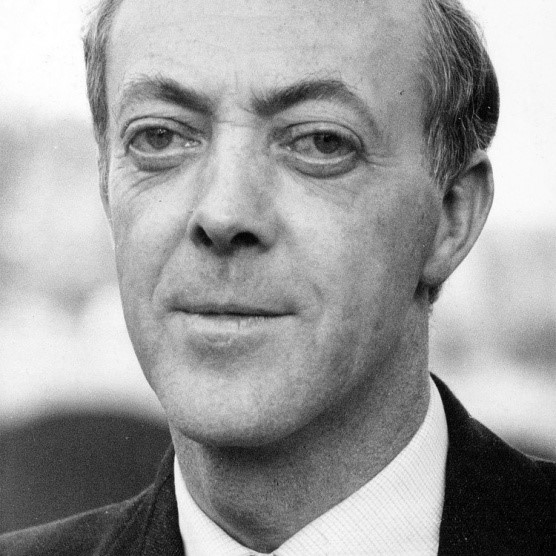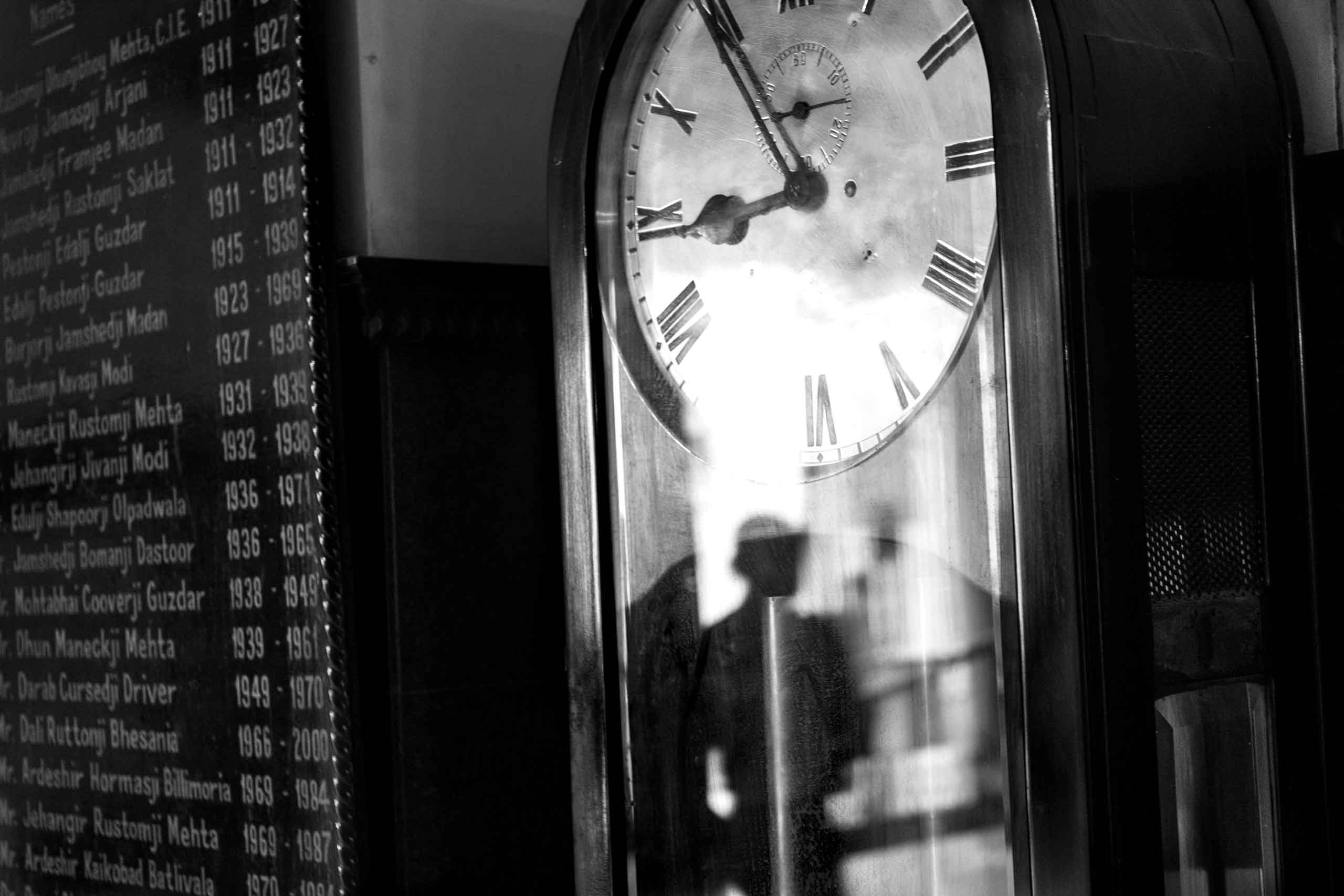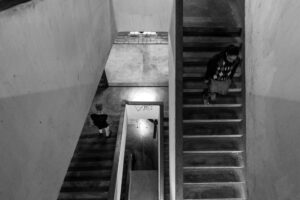In this blog post, Dr. Natasha Remoundou discusses the poem “Aifreann na Marbh” [Mass of the Dead] written by Eoghan Ó Tuairisc (Eugene Watters) and published in 1964. Quotations are from the bilingual edition of the poem published in Louis de Paor (ed.), Leabhar na hAthghabhála / Poems of Repossession (2016). English translation by Colbert Kearney.

In a letter to his friend Richard Kell in 1965, bilingual poet, Eoghan Ó Tuairisc / Eugene Watters anachronistically recalls the moment when he first heard about the catastrophe of Hiroshima while on his honeymoon in Waterford:
“[…] first newspaper for many weeks, whole page, the A-bomb, Hiroshima. We were on a train, bright August light through the window. I can still see the black headlines, and the shock. As if I had been sleeping for years, jerked now awake.” (quoted in McCabe, 2005: 131)
The traumatic memory of the event that had lingered for two decades in Ó Tuairisc’s mind had now reached a turning point beyond time and place. The emerging writer could no longer be a prisoner inside the Platonic cave of shadows. Confronted with that side of humanity eager to exact atrocities in the name of progress and technological advancement, the poet responds to the bombing of Hiroshima in the book-length poem The Weekend of Dermot and Grace (1964) and in the poem “Aifreann na Marbh”(“Mass of the Dead”) included in his first Irish-language collection Lux Aeterna (1964). Both works were published on the same day.* This post will focus on the latter. Written in Irish, and divided into nine parts,** the epic poem hauntingly captures the turbulent, transnational trepidations of a history of violence as a result of the nuclear annihilation of the Japanese cities of Hiroshima and Nagasaki. As Colbert Kearney argues “in any exchange, Eugene/Eoghan was always conspicuous by his sense of a general pattern underlying the comings and goings of human history” (91) that gave form to his thought and writing. Through a post-humanist critique of Western civilization after WWII and at the height of the Cold War, the poem builds upon universal connections that transcend a purely Irish context. Thus, it is simultaneously damning of the Western powers, of the United States, but also of Ireland’s burdensome political stance of neutrality during WWII (euphemistically renamed ‘The Emergency’) and its collective guilt. At a time when few people “wished to hear of Hiroshima” (Kelly 109), “Aifreann na Marbh” enunciates a radical and profound sense of discontent with the ethical bankruptcy of humanism in the 20th century contemplating at the same time the role of the poet in addressing the injustices and abuse of power.

With a two-fold prolegomenon, a dedication commemorating those “who died at Hiroshima/ Monday, 6 August, 1945” and an epigram from Dante Alighieri’s La Divina Comedia, the poem’s opening lines reveal a near-apocalyptic vista over Dublin where the uncanny sunrise is reminiscent of a nuclear blaze. From the first stanza, the poem is framed as a dirge questioning the political, ecological, and ethical sustainability of the modern age. Attuned to the ontological ramifications of the material destruction of the nuclear era (see Braidotti 1993: 9), the speaker, like another Odysseus, has embarked on an urban journey haunted by his own troubled conscience. He believes that he along with everyone else he encounters along his wanderings through Ireland’s capital is complicit with the tragedy of Hiroshima. The action takes place within a single day in the ‘unreal’ capital city of Dublin’s urban wasteland, the day Hiroshima was destroyed by ‘Little Boy,’ the world’s first atomic bomb. Hiroshima is the ghost and Dublin its shadow at the heart of darkness personified as the apparition or mirage of a young woman wearing a kimono. In his quest for the truth, the free but guilt-ridden speaker outside of the cave finds neither refuge nor solace or freedom:
| Morning awakens our eternal unrest. I watch through a pane of glass The belfries of the children of Adam Our slates, our Creed, our courts, Floating in the freshness. Out of the mist she bears herself to me The immaculate maiden city In the act of resurrection. Morning awakens our eternal unrest. (p. 167) | Músclaíonn an mhaidin ár míshuaimhneas síoraí. Breathnaím trí phána gloine Clogthithe na hÁdhamhchlainne Ár gcuid slinn, ár gCré, ár gcúirteanna Ar snámh san fhionnuaire. Nochtann as an rosamh chugam An ghlanchathair mhaighdeanúil Ag fearadh a haiséirí: Músclaíonn an mhaidin ár míshuaimhneas síoraí. (p. 166) |
The first and last lines recur throughout the poem like a chorus and a prayer in the requiem mass, pondering on the threat of Doomsday as a result of nuclear war. The layering of visions allows readers to perceive the journey in terms of a descent into the heart of darkness. The direct textual reference to Dante’s allegory of his journey through Heaven guided by Beatrice operates as the overarching canvas upon which Ó Tuairisc reinscribes the itinerary of his own writing and ethical quest.*** In the opening scene of The Divine Comedy, the reader is confronted with a supernatural dark forest where the poet himself, Dante, alone and frightened, has lost his way home. Like the ghost of the Roman poet Virgil who is about to show him Hell, the first memorable lines of Introitus grapple with this paradox: to find one’s way in a disoriented world. It is thus impossible to read the poem without the impression that we, as readers, are on the same quest of survival, caught between collective guilt and the fear of extinction. It is a solitary journey that is as much autobiographical as it is archetypal and ongoing:
| We are the dead who died In Dublin in an evil hour The sunlit blasphemous day We blasted Hiroshima. (p. 173) | Sinne na mairbh fuair bás In Áth Cliath is in antráth Lá gréine na blaisféime Shéideamar Hiroshima (p. 172) |
The post-war years that intervene during the gestation period of “Aifreann na Marbh” are crucial in an Irish and global context. Following the Universal Declaration of Human Rights in 1948 and the subsequent constitution of the Irish Republic in 1949, Ó Tuairisc’s writing aligns itself with responses by a number of writers and thinkers compelled to ruminate on what Antonio Gramsci defines as the social role of the intellectual. Similarly, Ó Tuairisc’s condemnation of weapons of mass destruction at the backdrop of Ireland’ neutrality during WWII while reflecting on the ethics of responsibility of the writer is akin to the writings of Máirtín Ó Cadhain, Louis MacNeice, and Samuel Beckett.**** Ó Tuarisc, like MacNeice and Beckett, displaces these cultural and political metaphors through a post-humanist critique, questioning the absurdity and futility of received notions of progress, freedom, and the universality of human rights in a post-WWII, post-Hiroshima world. These ethical conflicts urged Ó Tuairisc to critical, universal questions of faith and humankind set against the possibilities of a post-atomic future. In Kyrie, the poet-speaker prays for mercy to the Lord for the “scientific lust” of our “restless generation” and “the filthy weather we created for ourselves”. [Dár n-ainmhian eolaíochta déan trua, / Foilsigh trí shalachar na haimsire / A chruthaíomar dúinn féin, an ghrian nua.] The reverberations of this unflinchingly resonant call sound very familiar right now more than ever.
“Aifreann na Marbh” is composed at the backdrop of Ireland’s social, political, and economic transformations, an era marked by emigration and economic stagnation, on the one hand, and the processes of modernisation, on the other. Ireland is admitted to the United Nations and sends the first Irish soldiers to serve in Lebanon, while Dr Walton of Trinity College Dublin along with John Cockcroft win the Nobel Prize for Physics for their scientific breakthrough in splitting the atom. In Northern Ireland, the emergence of the Civil Rights movement coincides with the outset of The Troubles and the end of censorship. Yet, “the victory we achieved/ in mathematics, space, the latest theory,” Watters writes, does not suffice against the high hopes of humanism.
Ó Tuairisc locates the zone of ethical responsibility in poetry. Halfway through the poem, in Hostias et Preces, the poet who has reached Purgatory seeks “to atone for what we have turned a blind eye to since then/ a glance at the truth, a poet (189) [I ndíol ar ar dhallamar ó shin i leith / Tugaim catsúil ar an bhfírinne, file (188)]. The source of Ó Tuairisc’s poetic dirge after Hiroshima is an ethics of confronting the other beyond the self through a refracted image. Likewise, throughout the poem the “sight” of Dublin is a spectre that he gazes at “through a pane glass” as an apparition. “I regard again with present tense eyes” [Dearcaim arís trí shúile freacnairce] Ó Tuairisc writes, and listens to the silence amplified “making us aware of / the torpor of the desert we are in” [ ag cur in iúl/ Dhíomhaointeas an dísirt ina bhfuilimid] (170/171). More importantly, the poem echoes a number of thinkers and writers who openly denounced the atomic bombing of Hiroshima. It is thus indebted to artists and thinkers like Albert Camus whose article in Combat on August 8th, 1945, condemned the advent of the atomic age as:
a discovery which primarily serves to unleash the most formidable destructive rage that man has witnessed in centuries. In a world exposed to unbounded heartrending violence, incapable of any control, indifferent to justice and the simple happiness of humankind; undoubtedly no one – except through ardent idealism – would dream of being astounded that science consecrates itself to organised murder.
Responses to Hiroshima as a marker of extreme brutality and moral failure include voices such as those of George Batailles, Jean-Paul Sartre, Jacques Derrida, and Bertrand Russell. Sartre famously intervened in three congresses of the World Peace Council in Vienna, Berlin, and Helsinki where he advocated for building an international solidarity movement among nations that would oppose the escalating threat of nuclear war and that could ultimately restore political and economic sovereignty in post-war, crushed Europe. In the midst of the Cold War in 1955, Russell along with Albert Einstein and other signatories issued the Russell–Einstein Manifesto highlighting the catastrophic effects of nuclear weapons of mass destruction urging world leaders to seek peaceful resolutions to international conflict. “Aifreann na Marbh” is also in conversation with Alain Resnais’ film Hiroshima mon Amour (1959), a film that intermixes real historical footage of post-war Hiroshima with a fictional love story scripted by Marguerite Duras, a forerunner of the docu-fictional genre in film.
Both the inception and the reading journey undertaken in “Aifreann na Marbh” after Hiroshima emerge from the depths of the metropolis as from a modern Platonic cave. Like Dante’s Divine Comedy, it climaxes in an ascent. Before this has taken place, the poem interrogates the legacies of the atomic age, faith, and Western civilization. Acutely aware of the paralyzing effects that traumatic historical events have upon the human psyche while building its subtle narrative based on the sweeping post-humanist cosmological and metaphysical scope of ethics, the poem culminates in the poet’s room, as a modern requiem of survival or atonement:
| Inner peace comes, In the Word springing from the heart of darkness And the poetry returns to the source. | Tagann suaimhneas anama San Fhocal ag broinneadh ó chroí na dorchachta Agus filleann an fhilíocht ar an bhfoinse. |
* Both works are equally autobiographical and preoccupied with the social and moral ramifications of the post-WWII era, specifically the sense of living in the post-Hiroshima world, the conjuring of the image of the victims of Hiroshima as human ‘photoglyphs’ is central in both works.
** Drawing on the structure of the Catholic liturgy, with intertextual references to Greek tragedy and mythology and Latin epic, the nine parts are titled as follows: Introitus (Introduction), Kyrie (Lord), Graduale (Liturgy sung from the altar steps), Dies Irae (The Day of Wrath), Hostias et Preces (Sacrifices and Prayers), Qui Venit (She who Comes), Da Nobis Pacem (Grant Us Peace), Lux Aeterna (Eternal Light), and Requiem (Lament).
***For a detailed analysis of the intertextual links between La Divina Comedia and “Aifreann na Marbh” see Mícheál Mac Craith’s online article published on the webpage of the Italian Institute of Culture (Instituto Italian di Cultura), on January 3rd, 2020.
**** On the themes of atomic power in the work of Máirtín Ó Cadhain, see Máirín Nic Eoin, “Bagairt an Díothaithe: Máirtín Ó Cadhain, an chumhacht adamhach agus ceist na teanga” [Threat of Extinction: Máirtín Ó Cadhain, atomic power, and the language question] (forthcoming in 2022); See Louis MacNeice’s poem “Neutrality,” in Collected Poems (Faber and Faber, 1979) 202; Beckett who was a volunteer with the Irish Red Cross in France wrote of the Irish back home “my friends eat sawdust and turnips while all of Ireland safely gorges”. Flann O’Brien controversially coined the macabre pun “abombic tomb” to critique the modern nuclear age that had resulted in mass tombs.
Bibliography:
Braidotti, R., 2013. The Posthuman (Polity).
Kelly, R., 1985. “Sidelines, Díseartáin, Redemption”, The Poetry Ireland Review (Eugene Watters Issue: “The Weekend of Dermot & Grace”) 13 (Spring): 106-116.
McCabe, J., 2005. “Hiroshima: Eoghan Ó Tuairisc and World War II”, New Hibernia Review 9(1): 117-140.
Ó Tuairisc, E., 2016. “Aifreann na Marbh” (trans. Colbert Kearney) in Louis de Paor (ed.), Leabhar na hAthghabhála / Poems of Repossession (Bloodaxe Books/ Cló Iar Chonnacht): 166-197.
View public lecture by Dr. Natasha Remoundou on “Aifreann na Marbh” and poetry after Hiroshima:





